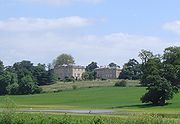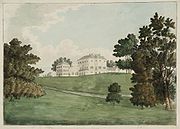
Nuneham House
Encyclopedia

Palladian architecture
Palladian architecture is a European style of architecture derived from the designs of the Venetian architect Andrea Palladio . The term "Palladian" normally refers to buildings in a style inspired by Palladio's own work; that which is recognised as Palladian architecture today is an evolution of...
, at Nuneham Courtenay
Nuneham Courtenay
Nuneham Courtenay is a village and civil parish about southeast of Oxford.-Manor:The toponym evolved from Newenham. In the 14th century the village belonged to the Courtenay family and in 1764 "Newenham" was changed to "Nuneham"....
in Oxfordshire
Oxfordshire
Oxfordshire is a county in the South East region of England, bordering on Warwickshire and Northamptonshire , Buckinghamshire , Berkshire , Wiltshire and Gloucestershire ....
England. It was built for Simon Harcourt, 1st Earl Harcourt
Simon Harcourt, 1st Earl Harcourt
Simon Harcourt, 1st Earl Harcourt, of Stanton Harcourt, Oxfordshire, PC, FRS, Viceroy of Ireland , known as 2nd Viscount Harcourt, of Stanton Harcourt, Oxfordshire, between 1727 and 1749, was a British diplomat and general....
in 1756. It is owned by Oxford University and is currently used as a retreat centre by the Brahma Kumaris World Spiritual University
Brahma Kumaris World Spiritual University
Brahma Kumaris World Spiritual University or Prajapita Brahma Kumaris Ishwariya Vishwa Vidyalaya is a monastic, renunciate Millenarian new religious movement of Indian origin...
. It is a Grade II* listed building.
Lord Harcourt demolished the old village in the 1760s in order to create a landscaped park around his new villa. He removed the village in its entirety, and recreated it along the main Oxford road (now the A4074). The house was built in 1757 by Stiff Leadbetter
Stiff Leadbetter
Stiff Leadbetter was a British architect and builder, one of the most successful architect–builders of the 1750s and 1760s, working for many leading aristocratic families.- Career :...
for the 1st Earl Harcourt, with the interior by James Stuart
James Stuart (1713-1788)
James "Athenian" Stuart was an English archaeologist, architect and artist best known for his central role in pioneering Neoclassicism.-Early life:...
. Lancelot "Capability" Brown designed the landscaped grounds.
In the 1760s Oliver Goldsmith
Oliver Goldsmith
Oliver Goldsmith was an Irish writer, poet and physician known for his novel The Vicar of Wakefield , his pastoral poem The Deserted Village , and his plays The Good-Natur'd Man and She Stoops to Conquer...
witnessed the demolition of an ancient village and destruction of its farms to clear land to become a wealthy man's garden. His poem The Deserted Village, published in 1770, expresses a fear that the destruction of villages and the conversion of land from productive agriculture to ornamental landscape garden
Landscape garden
The term landscape garden is often used to describe the English garden design style characteristic of the eighteenth century, that swept the Continent replacing the formal Renaissance garden and Garden à la française models. The work of Lancelot 'Capability' Brown is particularly influential.The...
s would ruin the peasant
Peasant
A peasant is an agricultural worker who generally tend to be poor and homeless-Etymology:The word is derived from 15th century French païsant meaning one from the pays, or countryside, ultimately from the Latin pagus, or outlying administrative district.- Position in society :Peasants typically...
ry. The Deserted Village gave the demolished village the pseudonym "Sweet Auburn", and Goldsmith did not disclose the real village tho which it refers. However, he did indicate it was about 50 miles (80.5 km) from London and it is widely believed to have been Nuneham Courtenay.

Henry Holland (architect)
Henry Holland was an architect to the English nobility. Born in Fulham, London, his father also Henry ran a building firm and he built several of Capability Brown's buildings, although Henry would have learnt a lot from his father about the practicalities of construction it was under Brown that he...
in 1781-2, including the heightening of the wings. In 1789 the 2nd Earl Harcourt re-erected the Carfax Conduit
Carfax Conduit
The Carfax Conduit was a water conduit that supplied the city of Oxford with water from 1617 until the 19th century.The conduit ran in an underground lead pipe from a spring on the hillside above the village of North Hinksey, beneath Seacourt Stream and the River Thames, to a building at Carfax in...
building in a prominent position in the park. It had had to be moved from Carfax
Carfax, Oxford
Carfax is located at the conjunction of St Aldate's , Cornmarket Street , Queen Street and the High Street in Oxford, England. It is considered to be the centre of the city, and is at...
in the centre of Oxford
Oxford
The city of Oxford is the county town of Oxfordshire, England. The city, made prominent by its medieval university, has a population of just under 165,000, with 153,900 living within the district boundary. It lies about 50 miles north-west of London. The rivers Cherwell and Thames run through...
, where it was an obstacle to traffic.
In 1904, after the death of Sir William Vernon Harcourt
William Vernon Harcourt (politician)
Sir William George Granville Venables Vernon Harcourt was a British lawyer, journalist and Liberal statesman. He served as Member of Parliament for various constituencies and held the offices of Home Secretary and Chancellor of the Exchequer under William Ewart Gladstone before becoming Leader of...
, Nuneham House was passed to his son, Lewis Vernon Harcourt, 1st Viscount Harcourt
Lewis Vernon Harcourt, 1st Viscount Harcourt
Lewis Vernon Harcourt, 1st Viscount Harcourt PC was a British Liberal Party politician who held the Cabinet office of Secretary of State for the Colonies from 1910 to 1915...
, known by many as "Loulou". He had just married Mary Ethel Burns, who was a niece of American
United States
The United States of America is a federal constitutional republic comprising fifty states and a federal district...
financier and banker, J. P. Morgan
J. P. Morgan
John Pierpont Morgan was an American financier, banker and art collector who dominated corporate finance and industrial consolidation during his time. In 1892 Morgan arranged the merger of Edison General Electric and Thomson-Houston Electric Company to form General Electric...
. The estate inherited by the young couple was in need of major renovations, which they could not afford. For his niece, Morgan established a £52,000 ($260,000) line of credit at his London
London
London is the capital city of :England and the :United Kingdom, the largest metropolitan area in the United Kingdom, and the largest urban zone in the European Union by most measures. Located on the River Thames, London has been a major settlement for two millennia, its history going back to its...
bank, which he told her did not need to be repaid. The Harcourts used these funds to renovate the old buildings and grounds.
During World War II
World War II
World War II, or the Second World War , was a global conflict lasting from 1939 to 1945, involving most of the world's nations—including all of the great powers—eventually forming two opposing military alliances: the Allies and the Axis...
, Nuneham House and the park around it was requisitioned by the Ministry of Defence
Ministry of Defence (United Kingdom)
The Ministry of Defence is the United Kingdom government department responsible for implementation of government defence policy and is the headquarters of the British Armed Forces....
and became RAF Nuneham Park. It was a P.R.I.U.
JARIC
JARIC - The National Imagery Exploitation Centre, part of the Intelligence Collection Group within United Kingdom Defence Intelligence, is an imagery analysis and intelligence centre based at RAF Brampton near Huntingdon in Cambridgeshire, and historically known as MI4, by which name it is still...
or photographic reconnaissance interpretation unit. Examining the photographs taken by aircraft from RAF Benson
RAF Benson
RAF Benson is a Royal Air Force station near Benson in South Oxfordshire, England. It is home to the Royal Air Force's support helicopters, the Aérospatiale Puma and the EH-101 Merlin, known as the Puma HC.Mk 1 and the Merlin HC.Mk 3 and Mk 3a....
and other airfields over enemy territory, were not only RAF officers but also small contingents from the Army, Royal Navy and the USAAF. Nissen hut
Nissen hut
A Nissen hut is a prefabricated steel structure made from a half-cylindrical skin of corrugated steel, a variant of which was used extensively during World War II.-Description:...
s and other, larger, buildings were erected adjacent to the mansion, including a camp cinema which villagers were welcome to attend. The RAF station continued after the war in the same role until the mid 1950s, when the added buildings and roadways were demolished and the estate handed back to the Harcourt family, who sold it to Oxford University.
The Harcourt Arboretum
Harcourt Arboretum
Harcourt Arboretum is an arboretum owned and run by the University of Oxford. It is a satellite of the university's botanic garden in the city of Oxford, England...
, part of the tree and plant collection of the University of Oxford Botanic Garden
University of Oxford Botanic Garden
The University of Oxford Botanic Garden is an historic botanic garden in Oxford, England. It is the oldest botanic garden in Great Britain and one of the oldest scientific gardens in the world. The garden was founded in 1621 as a physic garden growing plants for medicinal research. Today it...
, occupies part of what were the grounds of Nuneham House.
Sources
External links
- "View of Nuneham Courtenay from the Thames" (1787) — painting by Joseph Mallord William Turner (1775–1851) at Tate Online

